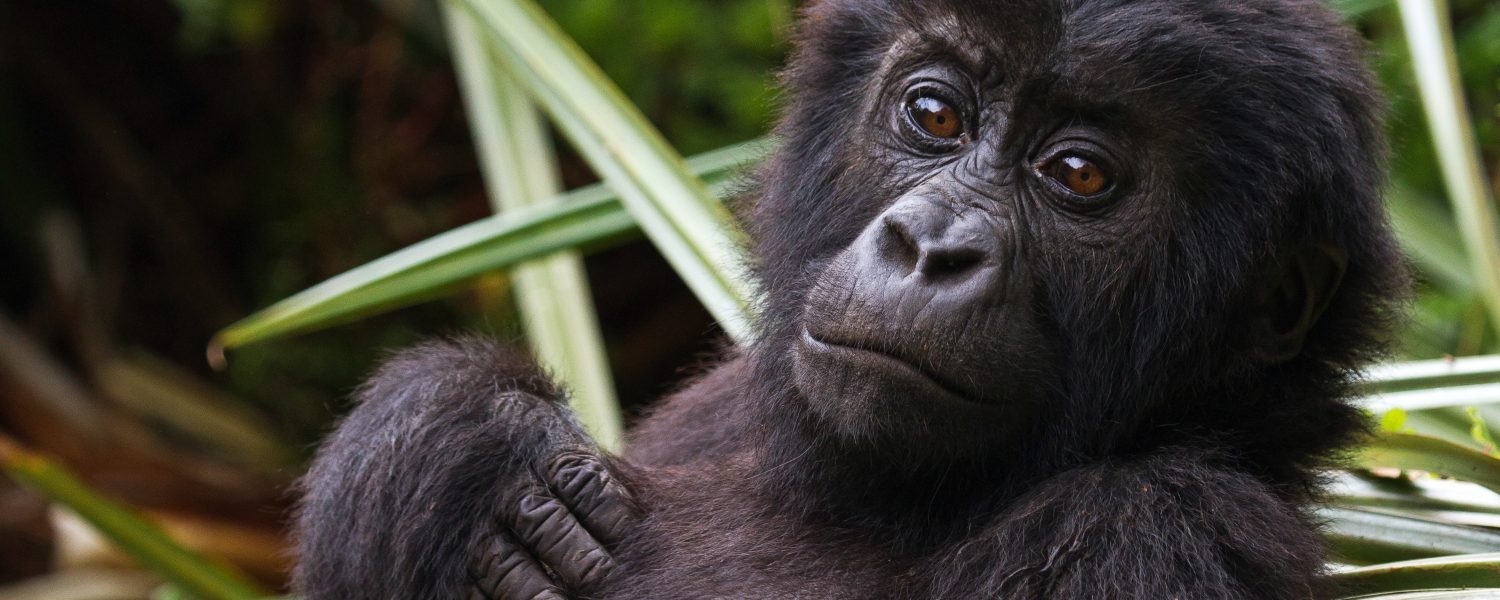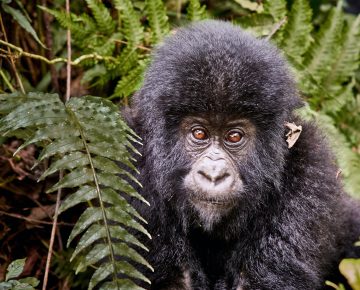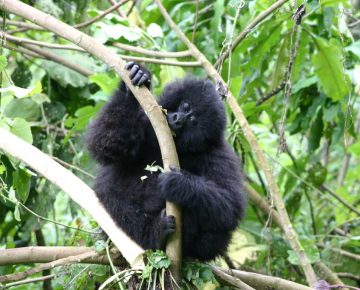Gorilla trekking in Africa is such an amazing adventure that allows travelers to get up close with the gentle giants. The other gorilla species, western gorillas and cross-river gorillas can be found across the central and other regions of the African continent. Therefore, one has an opportunity to interact directly with the enormous mountain gorillas while on an East African gorilla safari. The two species can be distinguished by the thickness of their fur and the difference in body size. Eastern gorillas are larger and have more body fur than the western gorillas. According to the recent census, there are roughly 5,000 eastern gorillas in the world, of whom about 1064 are mountain gorillas. Even though gorillas and humans live in very different settings, it is thought that they share a common ancestor. The DNA of gorillas is 98% similar to that of humans.
The world’s toughest primate species is the gorilla. They are sociable animals that live in troop-style communities. Each troop is commanded by a dominant male, known as “a silverback”. Female Gorillas are the majority in any group and have the responsibility of reproduction and nursing the young ones. Silverback keeps the entire group safe and explores new areas each day as they go. They own the forest, therefore each day they move from one territory to another.
How is gorilla trekking in Africa done?
A typical gorilla trekking session in Africa (Uganda, Rwanda, and Congo) starts with a briefing at the Park headquarters. It is important to start with a delicious breakfast at your accommodation facility – usually a safari lodge near or within the park. Meet and greet your guide at about 6:30 am and then drive or walk to the park headquarters. For Bwindi Impenetrable National Park, you will visit the park headquarters depending on the sector you are in. Remember, Bwindi National Park has 4 sectors namely; Buhoma Sector, Ruhija Sector, Nkuringo Sector, and Rushaga Sector. In Mgahinga National Park, you will visit the Ntebeko Park headquarters. For Volcanoes National Park, you will report at Kinigi park headquarters.
During the briefing, you will learn about the dos and don’t of mountain gorilla trekking rules and regulations in Africa. Each gorilla family is tracked by 8 people per day. This is meant for the good of both trekkers and the gorillas. You will then embark on a walk to forests with an experienced and armed ranger. The rangers take time (usually the night before the trek) to know where the gorillas are. Gorillas are wild animals and they move in a natural and not fixed pattern. But with the help of an experienced guide or ranger, encountering gorillas in Africa is possible.
The precious hour in the presence of gorillas
Every African safari goer on a gorilla trekking tour in Uganda, Rwanda or Congo dreams of the one special hour spent in the presence of gorillas. Averagely, gorilla trekking takes between two to eight hours of the day. The walk in the forests and rugged terrain is a moment to beacon. Upon meeting the gorillas, trekkers or travelers are allowed to spend one hour in the presence of the gorilla family. This is the best time during a gorilla trekking safari or gorilla adventure tour in Africa. Trekkers take photos, and learn about the different behaviors of these gentle giants. Visiting a gorilla family with many babies is a double blessing. Seeing these little ones play and jump on the backs of their mothers cerates everlasting memories. Ensure to follow the gorilla trekking rules and regulations during your gorilla trekking tour.
Once this hour is done, trekkers return to their lodges for lunch and relaxation. Usually, trekkers are advised to pack lunch boxes during the gorilla trekking. This is because no one is always sure of how long it takes to meet the gorillas. You do not want to starve in forests of Bwindi or Virunga national parks.
Comparing gorilla trekking tours in Uganda, Rwanda, and Congo
One of the frequently asked questions about gorilla trekking tours in Africa, is compare gorilla trekking in Uganda, Rwanda and Congo. Generally gorilla trekking in all the three safari destinations is the same except a few things make the difference. Except lowland gorilla trekking in Congo, mountain gorilla trekking in Virunga, Volcanoes, Bwindi, and Mgahinga national parks is identical. The differences only lie in the terrain, gorilla trekking permit prices, and the number of habituated mountain gorilla families. For instance, Bwindi Impenetrable National Park is made up of 4 gorilla trekking sectors. Each sector has a different terrain and specific number of gorilla families. Bwindi Impenetrable National has 26 habituated mountain gorilla families available for trekking. On the other hand, Volcanoes National Park has 10 habituated mountain gorilla families. Mgahinga National Park has one habituated mountain gorilla family known as Nyakagezi gorilla group.
In terms of price mountain gorilla permits in Uganda and Congo are cheaper than those of Rwanda. A gorilla trekking permit in Uganda costs USD 800 per person per trek. On the other hand, a gorilla trekking permit in Rwanda costs USD 1,500 per person per trek. In Congo, a gorilla trekking permit costs USD 450 per person. In terms of accessibility, Volcanoes National Park can easily be accessed from Kigali International Airport (3 hours). This is easier than the 8-hour drive from Entebbe International Airport to Bwindi or Mgahinga parks. This should not scare you though, one can do a gorilla trekking safari in Uganda from Kigali. It takes only 4 hours to drive from Kigali International Airport to reach Bwindi Impenetrable National Park.
Booking a gorilla trekking permit in Africa
Are you planning a gorilla trekking tour or safari to Uganda, Rwanda, or Congo and wondering how to book gorilla permit? Do not fret. Booking gorilla trekking permits in Uganda can be booked through a reputable tour operator or tour company. Your local tour operator will then contact the Uganda Wildlife Authority and process your gorilla trekking permit to Bwindi or Mgahinga parks. In Rwanda gorilla trekking permits are also booked through tour operators. The body in charge of issuing these permits is Rwanda Development Board. In Congo, gorilla trekking permits can be got at the park entrance or gate. But booking with Native Africa Tours Ltd takes away the hustle.
Please note that gorilla trekking permits in East Africa are issued on a first-come-first-serve basis. During the high seasons, permits are highly demanded and one can miss out if they do not secure their permits early enough. You are therefore encouraged to book your gorilla permits at least 3 months before your trip.
Feeding habits among gorillas
Vegetables, fruits, stems, and insects are occasionally fed upon by these gorillas. Water is obtained from dew in the morning and from leaves and fruits they consume. Moms breastfeed their young, milk them, assist in tick removal, and rest on the fur. Infants move around, eat, play, and carry out activities like climbing trees and picking out fruits all day long. Gorillas will have moved into a new territory in two days, building their nests in the twilight.
Gorilla trekking is a component of any gorilla tour in Africa. It is a once-in-a-lifetime adventure and trekkers will be able to encounter gorillas in their natural habitat. The exercise begins very early in the morning after a 30-minute registration and pre-trek briefing, during which the ranger guides will go over the rules with visitors. These include not littering the park, not making noise, keeping a distance of about 7 meters from gorillas when taking photos, not looking directly into their eyes, properly disposing of human waste, and more.
Before being attached to a habituated family, the trekking paperwork will be verified. The trekking activity lasts between two and eight hours, depending on your hiking pace and the gorilla family’s movements, and there is a possibility to spot many plant species, birds, forest creatures, and primates. You will be granted one hour to take pictures and see gorillas up close while the ranger guide answers your questions. The ranger guide will walk you through this process when you come across the gorillas during their feeding, grooming, and playing sessions.
What to pack for a gorilla trekking tour in Africa?
A gorilla trekking safari in Uganda, Rwanda or Congo is never right with a wrong packing list. This does not however mean that you must carry everything. Some items can be purchased from the local markets while others can be got at the park entrances. Some of the items to park for a gorilla trekking safari to Africa include; sturdy hiking shoes, a refillable water bottle, a backpack to carry your essentials, travel documents, a camera or smartphone to capture moments, insect repellants, a rain jacket, and power-bank to keep your gadgets charged. Read the full list of things to pack for a gorilla trekking safari in Africa.
Where to stay on a gorilla trekking safari in Africa?
Spending a night near a rainforest on a gorilla trekking tour to Rwanda or Uganda is a rewarding adventure. Safari lodges in Bwindi Impenetrable National Park offer a tranquil stay to travelers on a Uganda safari. These lodges range from budget to mid-rang and luxury. It all depends on the number of days you intend to stay and the your travel budget. Volcanoes National Park on the other hand is famous for having some of the best luxury lodges and accommodation facilities. Rwanda is by far a luxury gorilla trekking destination. This implies that one needs to be financially prepared to take a tour to Rwanda. This should not scare you through. All you need is talking to an Africa Travel planner for an amazing trip.













